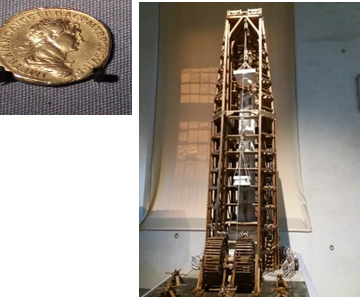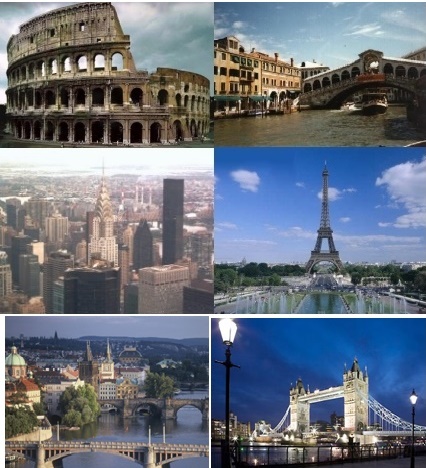di Mario Masciullo
A spectacular exhibition explains how the extraordinary monument (the Traian Column) was built, raised by the emperor Trajan in the heart of Rome, to celebrate the conquest of Dacia”, today’s Romania.
The art of building a masterpiece: the Trajan Column” is the title of the exhibition that the Uffizi Galleries dedicate to the famous monument erected in the heart of Rome in 113 AD from the first emperor of Iberian (Spanish) origins, Trajan, to celebrate the conquest of Dacia.
The exhibition, open to the public up to 06 October 2019 in the Limonaia Grande of the Boboli Gardens (Palazzo Pitti) in Florence, is based on an in-depth analysis of historical, archaeological and iconographic documents and tells the work in a new way, revisiting the construction story with strictly philological criteria.
 The techniques used to extract the twenty-nine gigantic marble blocks in the quarries of the Apuan Alps are therefore explained; the solutions designed to lead them to the port of Luni, embark them on the marble ships and unload them at the river port on the Tiber; the method used to drag them to the Fori ( ForiImperiali) area, where the construction site was set up.
The techniques used to extract the twenty-nine gigantic marble blocks in the quarries of the Apuan Alps are therefore explained; the solutions designed to lead them to the port of Luni, embark them on the marble ships and unload them at the river port on the Tiber; the method used to drag them to the Fori ( ForiImperiali) area, where the construction site was set up.
As the curator of the exhibition Giovanni Di Pasquale comments, “the Trajan Column, an expression of the artistic ability of man, like other monuments of antiquity, must also be framed within the technical and scientific knowledge that allowed its realization.
Its construction is nothing more than the culmination of an enterprise that begins much more north of Rome, in a quarry in the Apuan Alps, later called Fantiscritti, a privileged place for the extraction of that Luni marble that had been chosen to embellish monuments and buildings in the capital (Rome) and other places in the Empire.
The knowledge that made it possible to complete all the phases of that enterprise never recorded in writing, vanished with the end of the civilizations that put them into action. However, the dialogue between literary, archaeological, epigraphic, iconographic and numismatic sources makes it possible to reconstruct, at least in part, the pieces of that extraordinary adventure “.
As emphasized by the Director of the Uffizi Galleries Eike Schmidt, at the press conference, “Although many other fragments of that immense architectural universe that was the Forum Ulpium are present in the collections of the Uffizi Galleries, the two Dacians, porphyry sentinels guarding access in the Boboli Gardens they provide the most evident proof of the destiny that binds the Garden to the Trajan’s Column and its myth: no other context than the Boboli Garden (itself, after all, a sort of Renaissance translation of the imperial Horti surrounding Rome), it seems more suitable to revive the fortune and the fame of a monument that has always been felt as a paradigm of the glory of the Eternal City.
“At the centre of the exhibition path there are the scale models of the Trajan’s Column and the machines used in the construction. It is also possible to admire a rich selection of original finds, with exceptional loans from over 20 museums: they are reliefs, mosaics, scientific instruments, parts of construction machinery, and a precious tapestry depicting Trajan discussing with Apollodoro from Damascus, (his personal architect) author also of the project of the Column and the architect of the bridge on the Danube river.
“Imposing and solemn”, comments the Director of the Museo Galileo Paolo Galluzzi, “the Trajan Column has dominated the homonymous (Roman) Forum for almost two millennia. Yet among the immense mass of visitors who for centuries have stood admired in front of the monument, the number of those who wonder how it was possible to erect that powerful structure with the technical means available to the workers of the time is meager.
This is why we thought it appropriate to place at the center of the exhibition the reconstruction of the extraordinary adventure of building that monument, so as to bring out the ingenuity, the technical knowledge and the work of the men who made that achievement possible.
“The goal we set ourselves was to let the visitor enter the backstage of this memorable architectural feat, making him a spectator of this complex executive phases, in order to capture the boldness and ingenuity that characterized them.
The exhibition, designed by the Uffizi Galleries and the Galileo Museum, is curated by Giovanni Di Pasquale with the collaboration of FabrizioPaolucci. Joint Catalog.The collaboration with a great contemporary artist, the internationally known sculptor Claudio Capotondi, a refined shaper of white Carrara marble with the use of traditional methods and tools, which he has woven with Giovanni Di Pasquale and the authoritative members of the International Scientific Committee a prolonged and extremely fruitful dialogue.
We owe Capotondi the formulation of an absolutely plausible hypothesis on the monument building process.And not only that. In fact, Capotondi built with his own hands’ skilled craftsman the models of technical devices and lifting and positioning machines which the Roman craftsmen had to use for that daring architectural enterprise.
As if that was not enough, he offered an eloquent essay of his formidable vein as an artist, producing many dozens of spectacular graphics reconstructions of the entire realization cycle: a gallery of images of enormous expressive strength, which is configured as a sequence of frames that give life to a story with a fast and exciting rhythm.- (https://mostre.museogalileo.it/colonnatraiana traces-of-trajan-exhibition-virtual)https://www.uffizi.it/mostre-virtuali/sulle


